Washington D.C. – President Donald Trump announced a significant expansion of US New Tariffs on Wednesday, targeting seven countries with varying duty rates set to take effect in August 2025. This latest round of US New Tariffs represents a substantial escalation in the Trump administration’s trade policy, with import duties ranging from 20% to 30% on products from Algeria, Libya, Iraq, Sri Lanka, Brunei, Moldova, and the Philippines.
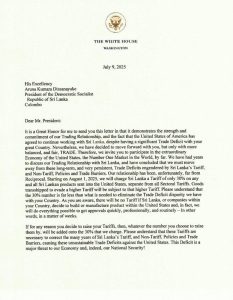
The announcement of these US New Tariffs came during a White House meeting with African leaders, where Trump outlined his administration’s approach to using trade as a diplomatic tool. The comprehensive nature of these tariffs signals a broader strategy to address what the administration characterizes as unfair trade practices and imbalances with multiple international partners.
Detailed Breakdown of New Tariff Rates
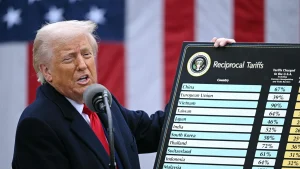

The US New Tariffs structure reveals a tiered approach to trade enforcement, with different countries facing varying levels of import duties based on their trade relationships with the United States. The highest rates target Algeria, Libya, Iraq, and Sri Lanka, each facing a substantial 30% tariff on their exports to the American market.
These US New Tariffs represent a significant adjustment from earlier proposals, with Iraq’s tariff reduced from the previously threatened 39% to 30%, and Sri Lanka’s duty lowered from 44% to 30%. Despite these reductions, the current rates still represent substantial barriers to trade for these countries.
Brunei and Moldova will face US New Tariffs of 25% on their products, while the Philippines will encounter a 20% levy on exports to the United States. This differentiated approach suggests the administration is attempting to calibrate its trade pressure based on specific bilateral relationships and trade dynamics.
Strategic Timing and Implementation
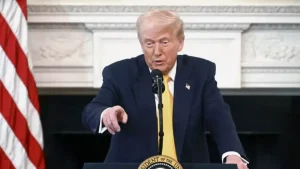

The timing of these US New Tariffs appears carefully calculated, with the August 1 implementation date providing countries with approximately three weeks to negotiate alternative arrangements with the United States. This timeline follows an earlier postponement from the original Wednesday deadline, indicating the administration’s willingness to extend negotiation periods while maintaining pressure through tariff threats.
The US New Tariffs announcement coincides with Trump’s meetings with African leaders, including representatives from Gabon, Guinea-Bissau, Liberia, Mauritania, and Senegal. Notably, these countries were exempted from the current round of tariffs, with Trump characterizing them as “friends of mine now,” suggesting that diplomatic relationships can influence trade policy decisions.
Also Read: Trump BRICS Tariff Rule: Mandatory 10% Tariff On BRICS Depicts Dollar Dominance
Trade as Diplomatic Tool
President Trump emphasized the role of US New Tariffs as a diplomatic instrument, explaining how trade policy can be leveraged to encourage peaceful resolution of international disputes. During his meeting with African leaders, Trump cited examples of how trade relationships could potentially help resolve conflicts between India and Pakistan, as well as Kosovo and Serbia.
The administration’s approach to US New Tariffs reflects a broader philosophy that economic pressure can incentivize diplomatic cooperation. Trump’s statement that “You guys are going to fight, we’re not going to trade” encapsulates this strategy of using commercial relationships to promote international stability.
This diplomatic dimension of US New Tariffs suggests that the administration views trade policy not merely as an economic tool but as a mechanism for broader foreign policy objectives, including conflict resolution and international cooperation.
Justification and Rationale
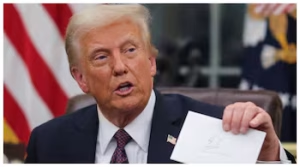
The US New Tariffs are justified by the Trump administration as a response to what they characterize as non-reciprocal trade relationships. The official letters sent to affected countries describe trade ties as “unfortunately, far from Reciprocal,” indicating that the administration views these tariffs as corrective measures rather than punitive actions.
The rationale behind these US New Tariffs centers on addressing perceived trade imbalances and encouraging countries to establish manufacturing operations within the United States. The administration’s approach suggests that these duties are designed to incentivize domestic production while reducing reliance on imports from targeted countries.
Trump characterized the tariff rates as based on “common sense” and trade imbalances, indicating that the administration believes these US New Tariffs represent proportionate responses to existing trade disparities rather than arbitrary punitive measures.
Broader Tariff Strategy and Expansion
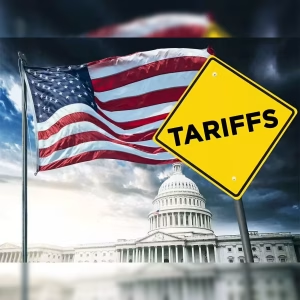
The current US New Tariffs represent part of a broader trade strategy that includes sector-specific duties on steel, aluminum, and automotive products implemented since Trump’s return to the White House in January. This comprehensive approach suggests that the administration is pursuing multiple tracks of trade enforcement simultaneously.
Trump announced that additional US New Tariffs would be implemented on copper and pharmaceuticals, indicating that the current round of tariffs may be followed by further trade restrictions. The administration also plans to send a letter to Brazil, suggesting that the list of countries facing trade pressure may continue to expand.
The escalating nature of these US New Tariffs reflects the administration’s commitment to addressing what it perceives as unfair trade practices across multiple sectors and countries simultaneously.
International Response and Retaliation Warnings
The US New Tariffs letters warn countries against retaliating against these duties, threatening further escalation if affected nations respond with their own trade restrictions. This preemptive warning suggests that the administration anticipates potential retaliation and is prepared to escalate trade tensions if necessary.
The administration’s approach to US New Tariffs includes incentives for countries to avoid these duties by establishing manufacturing operations within the United States. This strategy aims to encourage foreign investment and job creation while reducing import dependence.
Economic and Political Implications
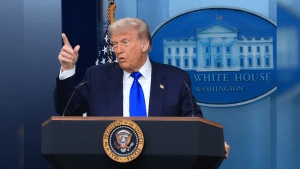

The implementation of these US New Tariffs will have significant economic implications for both the United States and affected countries. For American consumers, these tariffs may result in higher prices for imported goods, while domestic manufacturers may benefit from reduced foreign competition.
The political implications of US New Tariffs extend beyond economic considerations, as they represent a continuation of the Trump administration’s “America First” trade policy. These measures may strengthen support among constituencies that favor protectionist trade policies while potentially straining relationships with affected countries.
Final Statement: A New Era of Trade Enforcement
The announcement of these US New Tariffs marks a significant escalation in the Trump administration’s trade policy, affecting multiple countries across different continents. With implementation scheduled for August 1, these measures represent a substantial shift in international trade relationships and signal the administration’s commitment to using economic pressure as a tool for diplomatic and commercial objectives.
As these tariffs take effect, their impact on global trade patterns, diplomatic relationships, and domestic economic conditions will become increasingly apparent, potentially reshaping international commerce and foreign policy dynamics.

